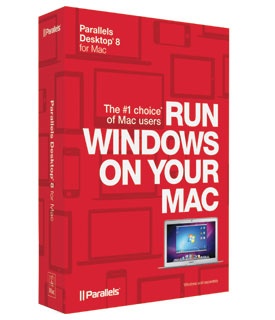MacTech Labs puts the new Parallels Desktop to the test to answer this question.
One of the most frequent questions we’ve been getting recently is “Should I upgrade to Parallels Desktop 8?” Even though this new version shipped several weeks back, we generally like to wait a bit as the updates for virtualization software that follow a major release often make a difference.
We decided to put Parallels Desktop to the test and compare version 8 to version 7, the previous version. This comparison is only about speed, and not about features.
The test was done on the current model MacBook Pro. Specifically, the MacBook Pro 15-inch 2.3GHz Intel Core i7, with 4GB of RAM, 500GB 5400RPM hard drive, and dual graphics configuration (Intel HD Graphics 4000 and NVIDIA
GeForce GT 650M with 512MB of GDDR5 memory). In addition, given the big differences for SSD drives, we also added in a MacBook Air 13-inch, 1.8GHz Intel
Core i5, with 8GB of RAM, and 256GB SSD.
The test was performed on OS X “Mountain Lion” 10.8.2 with all the current updates from Apple applied, and Parallels Desktop 7, and Parallels Desktop 8 running Windows 7 with all current updates applied.
And, because it can make a difference on the overall performance, we had not only Windows installed, but also Microsoft Office 2010 (something so many users commonly use virtualization for).
General Virtual Machine Performance
We wanted to see how the virtual machine performed in several areas. These included: launching the virtual machine with a full Windows boot, resuming a suspended virtual machine, compressing files, File IO, and, of course, graphics.
In most cases, Parallels Desktop 8 is faster. In particular, the Parallels Desktop experience on a machine with an SSD and plenty of RAM (in our case, the example was the MacBook Air) is a wonderful experience. Overall, Parallels Desktop 8 was noticeably faster than Parallels Desktop 7 – and it just felt “snappier” across the board.
What was faster?
• Launching the virtual machine with a full Windows boot took 17% less time – which in real world terms, means 6-7 seconds faster on a MacBook Pro.
• Launching the virtual machine from suspend took 15% less time if Parallels was already launched (33% less time on the MacBook Air).
• Compressing files, normally a difficult item to improve, took 11% less time to complete on a MacBook Pro. It took 7% less time on the MacBook Air which, given the performance of the SSD, gives a good indication on processing capabilities.
• File I/O (1GB file duplicate on the virtual hard drive) took 8% less time to complete on the MacBook Pro, and an astounding 18% less time on the MacBook Air.
• Overall Graphics (3Dmark06 Score) on both the MacBook Air and MacBook Pro was about 10-11% faster.
• Many of the individual graphics measurements were 25-30% faster (HDR, Vertex Shader, Shader Particles, Triangles, etc…).
What wasn’t?
• If you were launching a suspended virtual machine from the Finder (i.e., Parallels Desktop application wasn’t already launched), then it took 10% more time. It appears this is due to requirements from Apple related to Apple’s push towards the App Store. (Parallels Desktop is not yet available on the App Store, but it appears they are preparing for someday that current App Store limitations that affect virtualization software will be resolved).
• Launching the virtual machine with a full Windows boot was nearly identical on the MacBook Air.
3DMark06/Graphics Performance
If you’ve never heard of 3DMark, it’s the most popular 3D game performance benchmark. Specifically, “3DMark06 is a PC benchmark suite designed to test the DirectX9 performance of your graphics card.” A 3DMark score is an overall measure of your system’s 3D gaming capabilities, based on comprehensive real-time 3D graphics and processor tests.” Often, PC gamers will use 3DMark06 to tune their gaming platform. See http://www.futuremark.com/ .
The most important result is the “3DMark Score,” which is an aggregate score that judges the overall 3D graphics performance. As you may remember from previous benchmarks, Parallels Desktop 7, and version 6 before it, were very fast. Parallels Desktop 8 builds on that platform with additional graphics speed increases. In some cases, some tests took 2/3 less time to complete. And, overall, Parallels Desktop 8 is about 10-11% faster than Parallels Desktop 7 in graphics.
Conclusion
In answer to the question “Should I upgrade to Parallels Desktop 8?” In short, if you are using virtualization regularly, the answer is a resounding yes. There’s a feel to the environment that is just smoother across the board, and the faster boot time, disk performance, and graphics are both welcome and noticeable.
Parallels Desktop 8 for Mac is $79.99. Parallels Desktop 8 for Mac (2 License Pack) is $119.99. Parallels Desktop 8 for Mac Upgrade (from Parallels Desktop versions 6 and 7) is $49.99. See http://www.parallels.com/products/desktop/ for more information.
By Neil Ticktin, editor-in-chief/publisher, MacTech



